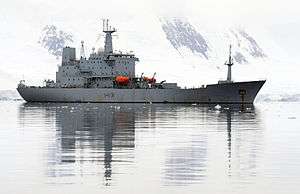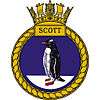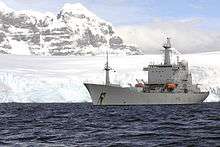HMS Scott (H131)
HMS Scott is an ocean survey vessel of the Royal Navy, and the only vessel of her class. She is the third Royal Navy ship to carry the name, and the second to be named after the Antarctic explorer, Robert Falcon Scott. She was ordered to replace the survey ship HMS Hecla.[1]
 HMS Scott at the British Antarctic Territory, 2010 | |
| History | |
|---|---|
| Name: | HMS Scott |
| Operator: | Royal Navy |
| Ordered: | 20 January 1995[1] |
| Builder: | Appledore Shipbuilders, Bideford (Subcontracted from BAeSEMA) |
| Launched: | 13 October 1996[1] |
| Commissioned: | 30 June 1997[1] |
| Refit: | Major 2013-2014 |
| Homeport: | HMNB Devonport, Plymouth |
| Identification: |
|
| Status: | in active service |
| Badge: |
 |
| General characteristics [1] | |
| Class and type: | Scott-class ocean survey vessel[3] |
| Displacement: | 13,500 t (13,300 long tons; 14,900 short tons) |
| Length: | 131.1 m (430 ft) |
| Beam: | 21.5 m (71 ft) |
| Draught: | 8.3 m (27 ft) |
| Propulsion: |
|
| Speed: | 18 knots (33 km/h; 21 mph) |
| Complement: | 78 |
| Sensors and processing systems: |
|
Construction
The ship was ordered from BAeSEMA in 1995 to replace the ageing HMS Hecla. She was built at the Appledore Shipbuilders in North Devon and launched on 13 October 1996 by Mrs Carolyn Portillo,[4] wife of Michael Portillo, the then-Secretary of State for Defence. She was commissioned on 20 June 1997. Not only is she the largest vessel in the Royal Navy's Hydrographic Squadron, and the fifth largest in the entire fleet, but she is also the largest survey vessel in Western Europe.
Role
Scott is the Royal Navy's only ocean survey vessel.[5] She can remain at sea for up to 300 days a year, thanks to her crew rotation system. Her complement of 78 is divided into three sections: two sections are required to keep the ship operational, with the third on shore on leave or in training.[4] When the ship returns to port, one crew section on board is replaced by the section on shore. The ship can then deploy again almost immediately. As with all of the Royal Navy's large survey vessels, Scott has an auxiliary role in support of mine countermeasure vessels.[1]
Service
In February 2005 Scott surveyed the seabed around the 2004 Indian Ocean earthquake, which varies in depth between 1,000 m (3,300 ft) and 5,000 m (16,000 ft). The survey, conducted using a high-resolution, multi-beam sonar system, revealed that the earthquake had made a huge impact on the topography of the seabed.
In September 2006, Scott was granted the Freedom of the City of Swansea.[6] From August 2008 until June 2009 she was refitted in Portsmouth.[7]

On 26 October 2009[7] and again on 25 November 2010[8] the ship deployed to the South Atlantic and Antarctic to cover for the non-availability of the Royal Navy icebreaker HMS Endurance.[9] In February 2010, Scott hosted artist Rowan Huntley for a month in Antarctica, in a new artist-in-residence programme for the Royal Navy inaugurated by the Friends of the Scott Polar Research Institute (SPRI).[10]
In June 2010, the ship visited Cardiff to mark the centenary of Robert Falcon Scott's departure from Cardiff on 15 June 1910 for the South Pole, at the start of the Terra Nova Expedition.[11] In February 2011, Scott hosted Dafila Scott, Scott's granddaughter, in Antarctica for a month as the Friends of the SPRI's second artist-in-residence.[12]
The ship returned to Devonport in April 2011.[13] With the task of Antarctic patrol taken over by HMS Protector in that year,[14] Scott left Devonport in September to resume deep-water surveying, initially in the Atlantic.[13] From November 2013 to June 2014 her most extensive refit to date took place, in Devonport. This included coating the hull with Hempasil X3 non-toxic anti-fouling paint, which is expected to increase her fuel efficiency.[15]
The Ministry of Defence stated in October 2017 that the planned out-of-service date for Scott is 2022.[16]
Affiliations
- 42 Engineer Group (Geographic), Royal Engineers[17]
- City and County of Swansea[6][17]
- Plymouth Child Development Centre (Scott Hospital, Plymouth)[17]
- TS Scott - Maidstone Sea Cadets[17][18]
- The Captain Scott Society[17][19]
- The Worshipful Company of Water Conservators[17]
References
- Jane's Fighting Ships, 2004-2005. London, UK: Jane's Information Group Limited. p. 815. ISBN 0-7106-2623-1.
- "HMS Scott". FleetMon.com. Retrieved 20 June 2011.
- "Survey Vessels: HMS Scott". ArmedForces.co.uk. Retrieved 20 December 2008.
- "HMS Scott". Royal Navy. Archived from the original on 9 February 2008. Retrieved 15 November 2008.
- "HMS Scott". Royal Navy. Retrieved 23 March 2013.
- "HMS Scott accepts Freedom of the City". City and County of Swansea. 15 September 2006. Archived from the original on 27 September 2011. Retrieved 15 November 2008.
- "HMS Scott: The Journey to the Ends of the Earth". Royal Navy. 28 October 2009. Archived from the original on 26 November 2009. Retrieved 10 November 2009.
- "Scott takes Pole position again". Navy News. Archived from the original on 8 June 2011. Retrieved 11 February 2011.
- "HMS Scott deploys to Antarctic". Royal Navy. 29 October 2009. Archived from the original on 8 December 2009. Retrieved 10 November 2009.
- "Artist's month at threatened pole". BBC News. 6 February 2010. Retrieved 6 August 2014.
- "HMS Scott docks in Cardiff Bay". BBC News. 10 June 2010. Retrieved 6 August 2014.
- "Antarctica: Scott's granddaughter retraces his journey". BBC News. 3 February 2011. Retrieved 6 August 2014.
- "Antarctic survey vessel HMS Scott leaves Devonport base". BBC News. 13 September 2011. Retrieved 6 August 2014.
- Nimmo, Joe (24 June 2011). "HMS Protector is welcomed into the fleet". The News. Retrieved 6 August 2014.
- "Great Scott! New refit includes a slick "green" hull for Plymouth-based Royal Navy survey ship". Plymouth Herald. 21 June 2014. Archived from the original on 8 August 2014. Retrieved 2 August 2014.
- Pollard, Luke (30 October 2017). "HMS Scott:Written question - 109631". UK Parliament. Retrieved 31 October 2017.
- "HMS Scott Affiliations". Royal Navy. Archived from the original on 18 March 2013. Retrieved 23 March 2013.
- "Maidstone Sea Cadets". TS Scott 229. Archived from the original on 17 July 2011. Retrieved 7 March 2019.
- "Home". The Captain Scott Society. March 2007. Archived from the original on 17 September 2008. Retrieved 15 November 2008.